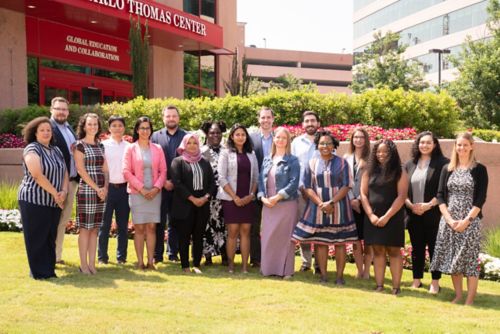St. Jude Family of Websites
Explore our cutting edge research, world-class patient care, career opportunities and more.
St. Jude Children's Research Hospital Home

- Fundraising
St. Jude Family of Websites
Explore our cutting edge research, world-class patient care, career opportunities and more.
St. Jude Children's Research Hospital Home

- Fundraising
Tailoring treatment for bone marrow failure syndromes

At St. Jude understanding bone marrow failure comes from integrating laboratory research with clinical care.
Where does cancer begin? For some patients, the answer is in their bone marrow, where a class of conditions called bone marrow failure (BMF) syndromes can be a precursor to blood cancer if not properly diagnosed and treated. In children, BMF syndromes are rare disorders in which the bone marrow does not make enough healthy blood cells.
Bone marrow is the spongy material inside bones that makes blood stem cells. These stem cells are the “factories” that make mature blood cells found in the bloodstream. Healthy bone marrow produces red blood cells, white blood cells and platelets. In children with BMF syndromes, their bone marrow does not work properly leading to dangerously low numbers of blood cells.
There are several distinct disorders that are classified as BMF syndromes. The treatment approach for such conditions is based on the underlying cause, so proper diagnosis is critical to choose the appropriate therapy.
A window of opportunity for treatment
Decades ago, when researchers were first describing these disorders, there were no therapies available. Today, with proper therapeutics and bone marrow transplantation, these syndromes can be cured. However, time is an essential factor because, left untreated, some of these conditions can progress to the pre-cancer condition called myelodysplastic syndrome (MDS). MDS often progresses to acute myeloid leukemia (AML), a blood cancer that is very difficult to treat. Additionally, If a transplant is not possible, patients’ lives can be a risk due to infections and organ problems.
At St. Jude, Marcin Wlodarski, MD, PhD, leads a clinic dedicated to BMF to provide expert opinion on patient cases to accurately diagnose and treat these disorders.
“We have a window of opportunity to treat these patients,” Wlodarski said. “The longer a patient with BMF is untreated, the worse their outcomes will be. The risk of cancer and other complications increases over time, but even when treated early, the options are still limited to transplantation, hematopoietic growth factors or steroids.”
“Pharmacotherapies have not really changed much in the last 40-50 years, but all bone marrow failure syndromes can be cured with a bone marrow transplant,” he added. “The most promising frontier for novel therapeutics for bone marrow failure is in genetics, both the inherited genetics that causes these disorders and the acquired genetics that can fuel them.”
High and low risk: All syndromes are not the same
Among these conditions that affect the production of blood cells, some are associated with a high risk of developing AML, while others are low-risk. How these patients are monitored for signs that cancer is beginning to form and how they would be subsequently treated depends on their specific condition, so accurate diagnosis is critical.
“There are three inherited BMF syndromes that have a very high risk of progressing to cancer; they require regular surveillance to ensure that cancer isn’t starting to form,” Wlodarski said.
- Fanconi anemia: the first BMF syndrome, which was identified 100 years ago in families with low blood cell counts, birth defects and increased cancer risk. It is caused by mutations in one of the 20 DNA repair genes, and over 95% of patients with Fanconi anemia have a known genetic cause. Patients have a high risk of developing leukemia and solid tumors.
- Shwachman-Diamond syndrome: a rare disorder that primarily affects white blood cell production, which can result in poor growth or skeletal abnormalities. There are now four genes implicated in the disorder, including the SBDS, ELF1, DNAJC21 and SRP54 genes.
- Severe congenital neutropenia: With over five genes affected, this disorder specifically affects neutrophils, a type of white blood cell that plays a role in immunity and infection protection.
There are also inherited BMF syndromes associated with a lower risk of blood cancer during childhood, requiring a different surveillance strategy. These include:
- Diamond-Blackfan anemia: an inherited BMF syndrome in which the bone marrow fails to make red blood cells essential for carrying oxygen throughout the body.
- Thrombocytopenia syndromes: conditions that occur when the production of platelets in the blood is affected. There are several inherited thrombocytopenia syndromes including:
- RUNX1 familial platelet disorder with associated myeloid malignancies (RUNX1-FPDMM) which is characterized by low platelet count and an increased risk of developing a hematologic malignancy.
- Thrombocytopenia syndromes due to mutations in ETV6 and ANKRD26 genes, associated with increased risk for hematologic malignancy.
- Congenital amegakaryocytic thrombocytopenia (CAMT) caused by mutations in the MPL gene which codes for thrombopoietin (TPO) receptor (c-MPL).
- Radioulnar synostosis with amegakaryocytic thrombocytopenia (RUSAT) due to mutations in MECOM and HOXA11 genes.
- Thrombocytopenia-absent radii (TAR) due to mutations in RBM8A gene.
- Dyskeratosis congenita: a condition that can cause both BMF syndromes and lung disease due to the presence of shortened telomeres (structures that typically protect DNA).
Within the last few years, researchers worldwide discovered three new MDS and AML predisposition syndromes. Unlike the classical BMF conditions discussed above, these new predisposition syndromes can present with MDS or AML almost “instantaneously” without preceding bone marrow failure. These inherited syndromes are:
- GATA2 deficiency: a condition caused by mutations in the blood transcription factor GATA2, leading to immunodeficiency and blood cancer in the affected children, adolescents and young adults.
- SAMD9 and SAMD9L syndromes: diseases that affect the production of blood stem cells and the development of other organ systems; for example, some patients can suffer from neurological problems (ataxia) or have insufficient hormone production (endocrinopathy).
- ERCC6L2 syndrome: a genetic predisposition syndrome associated with a high risk of developing acquired TP53 mutations that can cause treatment-resistant AML.
“How we treat a patient absolutely depends on which disorder they have, which is why the genetics is so critical,” Wlodarski said. “We want to get the diagnosis right, but for high-risk conditions, we also want to put genetic surveillance in place, which requires understanding the acquired mutations that contribute to these disorders to monitor them and know when different interventions are needed.”

Clinical and laboratory team members of the Bone Marrow Failure and MDS program.
Proper diagnosis shapes treatment
“Our practical approach to diagnosing bone marrow failure starts with the patient and family’s history,” Wlodarski says. The BMF team consists of highly specialized providers, including advanced practice providers, genetic counselors and nurses who can quickly recognize patterns of specific symptoms corresponding to known syndromes. They look at the patient’s complete blood count (CBC), a measure of the number of red blood cells, white blood cells and platelets in a blood sample. They will try to get this data from prior medical checkups to understand when the numbers may have become abnormal or started to shift and look at current counts. The team will look for infections, failure to thrive and family history in their assessment in addition to a physical exam, which can uncover congenital symptoms of these disorders — for example, heart defects, cleft lip/palate, or anomalies in the bones.
In the lab, pathologists search for signs of BMF in the most logical place - the bone marrow itself, looking for morphology (what the cells look like), dysplasia (the presence of abnormal cells) and the blast count (the number of immature white blood cells that could become cancerous). They also look for chromosomal abnormalities, particularly in chromosomes 7, 8 and 21, which are the most often affected by BMF in children. Their analysis also includes genetic testing for abnormalities in the specific genes implicated in these conditions.
Wlodarski and his team have a list of approximately 150 genes associated with BMF that they look for in patients. The team includes genetic specialists well versed in these abnormalities to help in proper diagnosis.
Genetics reveal additional BMF/MDS syndromes
St. Jude has also started a new Clinical Genomics (ClinGen) pipeline for BMF disorders, specifically. Any patient at St. Jude with cancer can be enrolled in the ClinGen pipeline. The St. Jude Departments of Pathology and Computational Biology established the new BMF ClinGen pipeline, which uses a two-platform approach with whole exome and genome sequencing, to identify the inherited genetic cause of the syndrome.
With the improvement of genomic technologies in the past few years, scientists have discovered additional syndromes associated with BMF. In particular, GATA2 deficiency and SAMD9/9L syndromes are common in children making up about 20% of cases. Wlodarski’s lab led this discovery and continues to research this subtype as well as run a registry for patients with this type of BMF. This registry collects data from patients worldwide to better understand the disease and help future patients.
“Genetics is the central pillar for caring for these patients, and it is also how we will develop novel treatments and even cures,” Wlodarski said.
Comprehensive diagnosis and treatment is possible only with a dedicated team of experts. The BMF/MDS clinic staff at St. Jude [as of August 2023] are: Nathan Gray (Physician Assistant), Michelle Boals (Nurse Practitioner), Melvanique Hale (Nurse Case Manager), Amanda Pullen (Social Worker), Niesha Clark (Teacher), Jessica Uhrich (Program Coordinator), Kelsey Ray (Clinial Research Associate), Richa Sharma (Instructor), Senthil Bhoopalan (Instructor), Tamanna Shamrin (Data Engineer), Sara Lewis (Genetic Counsellor) and Marcin Wlodarski (Director).
Wlodarski and colleagues in the Department of Hematology, including Mitchell Weiss, MD, PhD; Shengdar Tsai, PhD; and Senthil Bhoopalan, MBBS, PhD, are launching a large-scale endeavor to study and implement gene editing as a potentially curative treatment approach for BMF syndromes.
Research and clinical care go together
While providing clinical expertise, Wlodarski also runs a research laboratory at St. Jude, investigating these disorders. Recent findings from his lab defined the genetic landscape and evolution of SAMD9/SAMD9L and GATA2 syndromes and improved treatment approaches for secondary blood cancers, among other discoveries.
- Nature Medicine, Clinical evolution, genetic landscape and trajectories of clonal hematopoiesis in SAMD9/SAMD9L syndromes.
- Blood Advances, CPX-351 induces remission in newly diagnosed pediatric secondary myeloid malignancies.
- Blood, Gain-of-function mutations in RPA1 cause a syndrome with short telomeres and somatic genetic rescue.
- Blood, Association of unbalanced translocation der(1;7) with germline GATA2 mutations.
“St. Jude is uniquely positioned to be able to do this work, both from the clinical perspective, with a dedicated clinic, standardized treatment protocols, clinical genomics and a network of clinicians worldwide to suggest new therapies, but also from a research perspective, with the technological capability to dive deeply into the genetics and develop and refine gene editing techniques,” Wlodarski said. “These are all individually rare disorders, but their impact is significant, and by dedicating ourselves to finding better treatments and even cures for these diseases, we can learn more about how to cure other diseases as well.”






